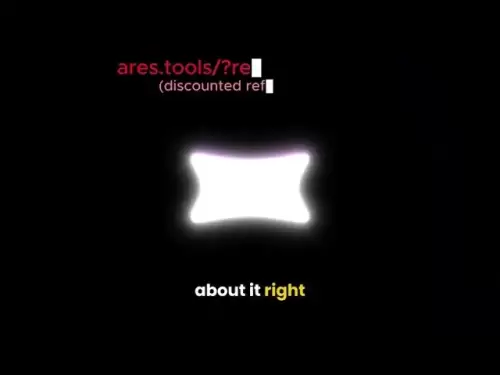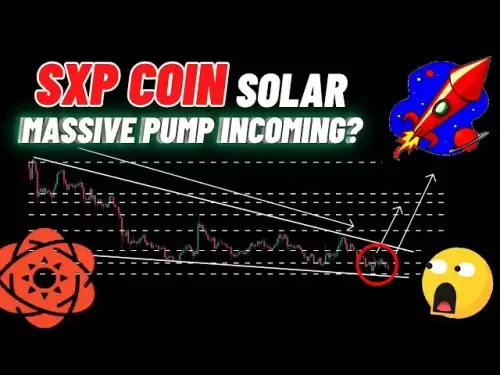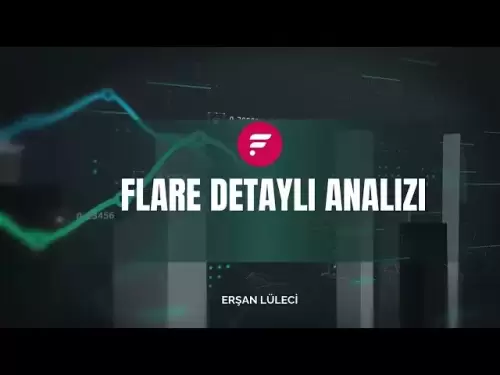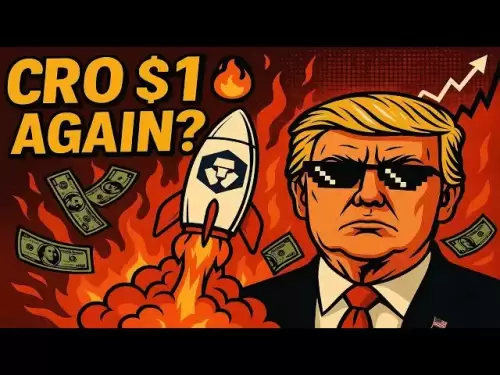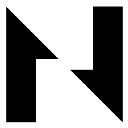-
 Bitcoin
Bitcoin $117400
1.93% -
 Ethereum
Ethereum $3747
3.63% -
 XRP
XRP $3.157
3.09% -
 Tether USDt
Tether USDt $1.000
0.02% -
 BNB
BNB $783.3
3.19% -
 Solana
Solana $186.6
5.64% -
 USDC
USDC $0.9999
0.01% -
 Dogecoin
Dogecoin $0.2375
5.42% -
 TRON
TRON $0.3185
1.32% -
 Cardano
Cardano $0.8191
3.28% -
 Hyperliquid
Hyperliquid $44.43
5.76% -
 Sui
Sui $3.995
9.84% -
 Stellar
Stellar $0.4396
6.27% -
 Chainlink
Chainlink $18.26
4.83% -
 Hedera
Hedera $0.2646
11.88% -
 Bitcoin Cash
Bitcoin Cash $553.5
5.55% -
 Avalanche
Avalanche $24.13
4.73% -
 Litecoin
Litecoin $113.3
1.77% -
 UNUS SED LEO
UNUS SED LEO $8.975
0.11% -
 Shiba Inu
Shiba Inu $0.00001405
5.69% -
 Toncoin
Toncoin $3.319
7.46% -
 Ethena USDe
Ethena USDe $1.001
0.02% -
 Uniswap
Uniswap $10.44
4.98% -
 Polkadot
Polkadot $4.098
4.31% -
 Monero
Monero $328.6
1.87% -
 Dai
Dai $1.000
0.01% -
 Bitget Token
Bitget Token $4.561
2.76% -
 Pepe
Pepe $0.00001261
5.29% -
 Aave
Aave $296.8
4.02% -
 Cronos
Cronos $0.1335
3.28%
What is the difference between Binance spot and futures positions?
Binance offers spot trading for direct crypto exchanges and futures trading with leverage for speculating on future prices, each with distinct benefits and risks.
Apr 10, 2025 at 01:28 pm
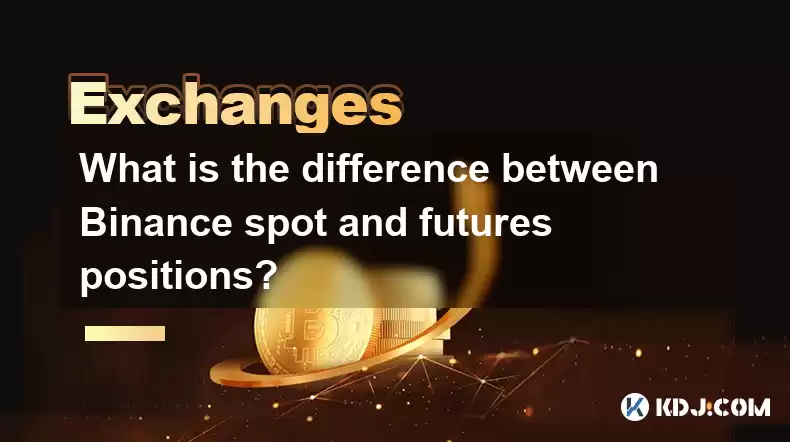
The world of cryptocurrency trading offers various ways to engage with the market, and two of the most popular methods on the Binance platform are spot and futures trading. Understanding the differences between these two types of positions is crucial for any trader looking to navigate the crypto markets effectively. In this article, we will delve into the specifics of Binance spot and futures positions, highlighting their key differences, benefits, and how they function within the trading ecosystem.
What is Binance Spot Trading?
Binance spot trading involves the direct exchange of one cryptocurrency for another at the current market price. When you engage in spot trading, you are buying or selling assets immediately, and the transaction is settled right away. This type of trading is straightforward and is often the first step for many new traders entering the cryptocurrency market.
In spot trading, you own the actual cryptocurrency you purchase. For example, if you buy 1 Bitcoin (BTC) on the spot market, you have full ownership of that Bitcoin and can hold it in your wallet or trade it later. The simplicity of spot trading makes it an attractive option for those who want to invest in cryptocurrencies without the complexities of leverage or derivatives.
What is Binance Futures Trading?
Binance futures trading, on the other hand, involves trading contracts that derive their value from an underlying asset, such as Bitcoin or Ethereum. Futures contracts allow traders to speculate on the future price of a cryptocurrency without actually owning the asset. This type of trading is more complex and typically involves the use of leverage, which can amplify both gains and losses.
When you trade futures, you are essentially betting on whether the price of the underlying asset will go up or down by a certain date. Futures contracts have an expiration date, and traders must either close their positions before this date or roll them over into a new contract. The use of leverage in futures trading means that traders can control a larger position with a smaller amount of capital, but it also increases the risk of significant losses.
Key Differences Between Spot and Futures Trading
The primary difference between Binance spot and futures trading lies in the nature of the assets being traded and the mechanisms involved. Spot trading involves the immediate exchange of cryptocurrencies, while futures trading involves contracts that derive their value from an underlying asset.
Another significant difference is the use of leverage. Spot trading does not involve leverage, meaning you can only trade with the funds you have in your account. In contrast, futures trading often involves leverage, allowing traders to borrow funds to increase their trading position. This can lead to higher potential returns but also increases the risk of substantial losses.
Additionally, the settlement process differs between the two. Spot trades are settled immediately, with the cryptocurrencies being transferred to your wallet upon completion of the transaction. Futures trades, however, are settled at a future date, and the outcome depends on the price of the underlying asset at the time of expiration.
Benefits of Spot Trading
Spot trading offers several benefits, particularly for beginners and those looking for a straightforward way to invest in cryptocurrencies. One of the main advantages is the simplicity of the process. You can easily buy and sell cryptocurrencies at the current market price without worrying about complex financial instruments or leverage.
Another benefit of spot trading is the ownership of the actual asset. When you buy a cryptocurrency on the spot market, you have full control over it and can hold it in your wallet for as long as you want. This can be appealing for those who believe in the long-term value of a particular cryptocurrency.
Furthermore, spot trading is less risky compared to futures trading. Since you are not using leverage, your potential losses are limited to the amount you have invested. This makes spot trading a more conservative approach to cryptocurrency investing.
Benefits of Futures Trading
Futures trading offers its own set of advantages, particularly for experienced traders looking to capitalize on short-term price movements. One of the main benefits is the ability to use leverage, which can amplify potential returns. With leverage, traders can control a larger position with a smaller amount of capital, potentially leading to higher profits.
Another advantage of futures trading is the ability to hedge against price volatility. By taking a position in a futures contract, traders can protect their existing cryptocurrency holdings from adverse price movements. This can be particularly useful for those who want to mitigate risk while still participating in the market.
Additionally, futures trading allows for greater flexibility in terms of trading strategies. Traders can take both long and short positions, allowing them to profit from both rising and falling markets. This flexibility can be a significant advantage for those who are skilled at predicting market movements.
How to Start Spot Trading on Binance
Starting spot trading on Binance is a straightforward process. Here are the steps you need to follow:
- Create a Binance account: Visit the Binance website and sign up for an account. You will need to provide your email address and create a strong password.
- Complete the verification process: To comply with regulatory requirements, you will need to complete the Know Your Customer (KYC) verification process. This involves submitting a government-issued ID and a selfie.
- Deposit funds: Once your account is verified, you can deposit funds into your Binance wallet. You can deposit cryptocurrencies or fiat currencies, depending on your location and the available options.
- Navigate to the spot trading section: On the Binance platform, click on the "Trade" tab and select "Spot" from the dropdown menu. This will take you to the spot trading interface.
- Choose your trading pair: Select the cryptocurrency pair you want to trade. For example, if you want to buy Bitcoin with USDT, you would select the BTC/USDT pair.
- Place your order: Decide whether you want to place a market order or a limit order. A market order will execute immediately at the current market price, while a limit order will only execute if the price reaches your specified level. Enter the amount you want to buy or sell and confirm your order.
How to Start Futures Trading on Binance
Starting futures trading on Binance involves a few more steps compared to spot trading. Here is a detailed guide on how to get started:
- Create a Binance account and complete the verification process: Follow the same steps as outlined for spot trading to create and verify your account.
- Enable futures trading: Go to the "More" tab on the Binance platform and select "Futures." You will need to agree to the terms and conditions and complete a short quiz to enable futures trading on your account.
- Deposit funds into your futures wallet: Navigate to the futures trading section and click on "Transfer." You can transfer funds from your spot wallet to your futures wallet. Note that you will need to use USDT or BUSD for futures trading.
- Choose your futures contract: Select the futures contract you want to trade. Binance offers a variety of contracts, including perpetual futures and quarterly futures. For beginners, perpetual futures are often recommended due to their flexibility.
- Set your leverage: Decide on the amount of leverage you want to use. Binance allows leverage up to 125x, but it's important to use leverage cautiously as it can amplify both gains and losses.
- Place your order: Decide whether you want to go long (buy) or short (sell) on the futures contract. You can place a market order or a limit order, similar to spot trading. Enter the amount you want to trade and confirm your order.
Risk Management in Spot and Futures Trading
Risk management is crucial in both spot and futures trading, but it is particularly important in futures trading due to the use of leverage. Here are some strategies to help manage risk:
- Use stop-loss orders: A stop-loss order can help limit your losses by automatically closing your position if the price moves against you. This is especially important in futures trading, where leverage can lead to rapid losses.
- Diversify your portfolio: Spreading your investments across different cryptocurrencies can help reduce risk. In spot trading, this means holding a variety of assets, while in futures trading, it means taking positions in different contracts.
- Start with small positions: Especially in futures trading, it's wise to start with small positions until you are comfortable with the market and the platform. This can help you learn without risking too much capital.
- Monitor your positions: Keep a close eye on your open positions and be prepared to adjust them as market conditions change. In futures trading, this may involve closing out positions before they expire or rolling them over into new contracts.
Frequently Asked Questions
Q: Can I switch between spot and futures trading on Binance?
A: Yes, you can switch between spot and futures trading on Binance. You will need to transfer funds between your spot and futures wallets, but you can easily navigate between the two trading sections on the platform.
Q: Is it possible to trade the same cryptocurrency on both spot and futures markets?
A: Yes, you can trade the same cryptocurrency on both spot and futures markets. For example, you can buy Bitcoin on the spot market and simultaneously take a position in a Bitcoin futures contract.
Q: How does the fee structure differ between spot and futures trading on Binance?
A: The fee structure for spot and futures trading on Binance is different. Spot trading fees are typically lower and are based on your trading volume and whether you are a maker or taker. Futures trading fees include both a trading fee and a funding fee, which can vary depending on the contract and market conditions.
Q: Can I use the same account for both spot and futures trading on Binance?
A: Yes, you can use the same Binance account for both spot and futures trading. However, you will need to enable futures trading separately and transfer funds between your spot and futures wallets as needed.
Disclaimer:info@kdj.com
The information provided is not trading advice. kdj.com does not assume any responsibility for any investments made based on the information provided in this article. Cryptocurrencies are highly volatile and it is highly recommended that you invest with caution after thorough research!
If you believe that the content used on this website infringes your copyright, please contact us immediately (info@kdj.com) and we will delete it promptly.
- Wall Street's Bitcoin Bonanza: ETF Filings Signal Crypto's Coming-Out Party
- 2025-07-26 15:10:12
- Bitcoin, Cynthia Lummis, and Freedom Money: A New York Perspective
- 2025-07-26 15:10:12
- Bitcoin, Altcoin Season, and Market Shift: What's the Deal?
- 2025-07-26 14:30:12
- PEPE, Altcoins, and Bitcoin: Navigating the Meme Coin Mania in 2025
- 2025-07-26 14:30:12
- UAE's Digital Asset Revolution: Stablecoin Regulations Take Center Stage
- 2025-07-26 10:40:11
- Whale Transactions and ENA Token: Decoding the Withdrawal Dynamics
- 2025-07-26 14:50:12
Related knowledge
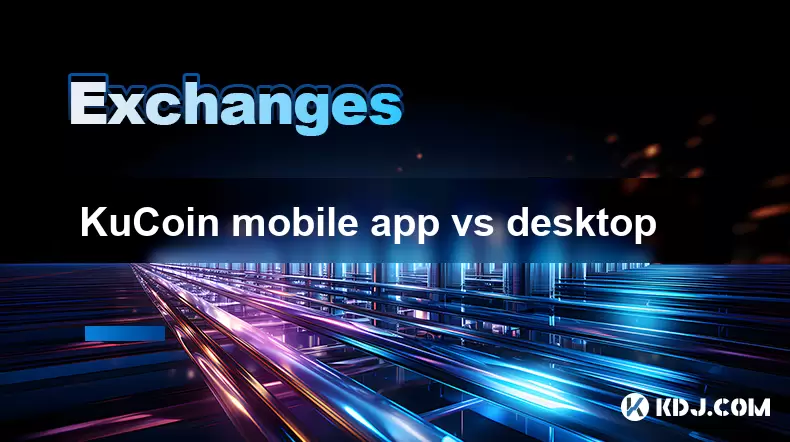
KuCoin mobile app vs desktop
Jul 19,2025 at 08:35am
Overview of KuCoin Mobile App and Desktop PlatformThe KuCoin ecosystem offers both a mobile app and a desktop platform, each designed to cater to diff...
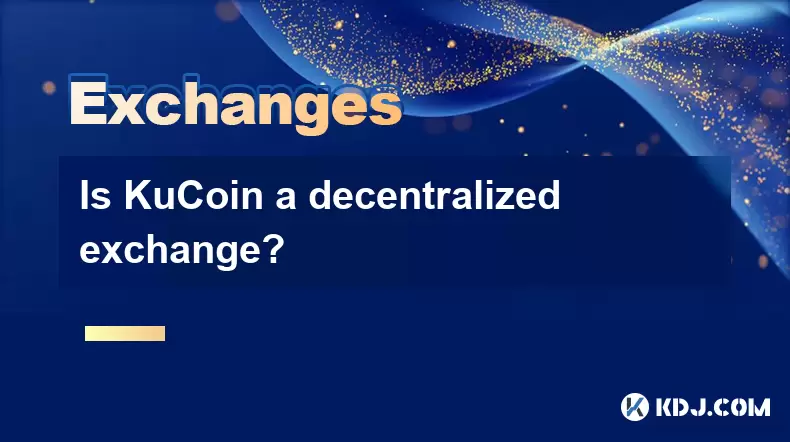
Is KuCoin a decentralized exchange?
Jul 18,2025 at 03:15pm
Understanding Decentralized Exchanges (DEXs)To determine whether KuCoin is a decentralized exchange, it's essential to first understand what defines a...
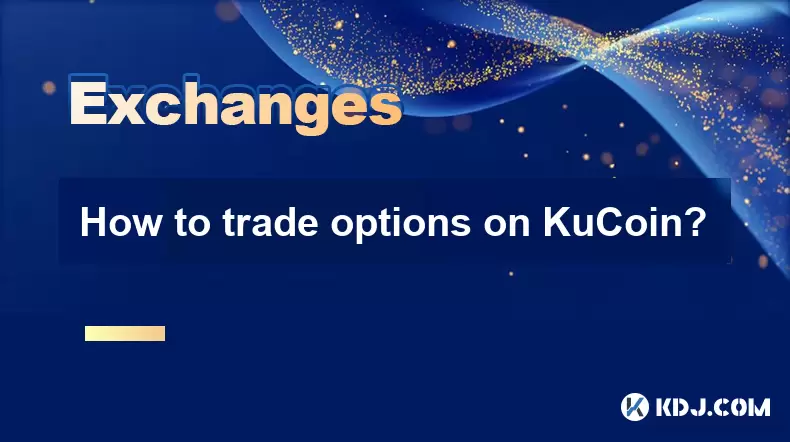
How to trade options on KuCoin?
Jul 19,2025 at 03:42am
Understanding Options Trading on KuCoinOptions trading on KuCoin allows users to speculate on the future price movements of cryptocurrencies without o...
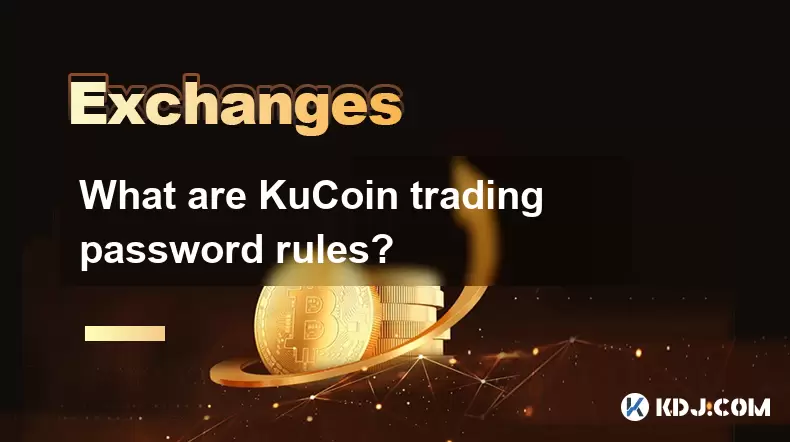
What are KuCoin trading password rules?
Jul 20,2025 at 07:56am
Understanding the Purpose of a Trading Password on KuCoinOn KuCoin, a trading password serves as an additional layer of security beyond the standard l...

Who is the CEO of KuCoin?
Jul 20,2025 at 09:35am
Background of KuCoinKuCoin is one of the largest cryptocurrency exchanges globally, known for its diverse range of trading pairs and user-friendly int...
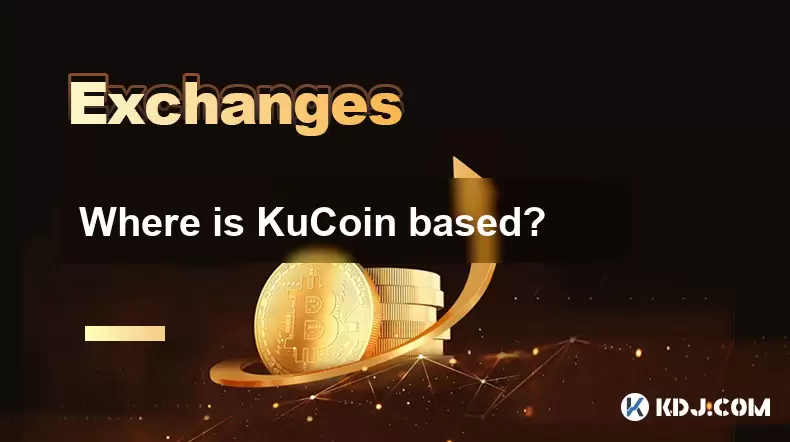
Where is KuCoin based?
Jul 22,2025 at 10:35pm
Understanding KuCoin's Global PresenceKuCoin is one of the most recognized names in the cryptocurrency exchange market, serving millions of users glob...

KuCoin mobile app vs desktop
Jul 19,2025 at 08:35am
Overview of KuCoin Mobile App and Desktop PlatformThe KuCoin ecosystem offers both a mobile app and a desktop platform, each designed to cater to diff...

Is KuCoin a decentralized exchange?
Jul 18,2025 at 03:15pm
Understanding Decentralized Exchanges (DEXs)To determine whether KuCoin is a decentralized exchange, it's essential to first understand what defines a...

How to trade options on KuCoin?
Jul 19,2025 at 03:42am
Understanding Options Trading on KuCoinOptions trading on KuCoin allows users to speculate on the future price movements of cryptocurrencies without o...

What are KuCoin trading password rules?
Jul 20,2025 at 07:56am
Understanding the Purpose of a Trading Password on KuCoinOn KuCoin, a trading password serves as an additional layer of security beyond the standard l...

Who is the CEO of KuCoin?
Jul 20,2025 at 09:35am
Background of KuCoinKuCoin is one of the largest cryptocurrency exchanges globally, known for its diverse range of trading pairs and user-friendly int...

Where is KuCoin based?
Jul 22,2025 at 10:35pm
Understanding KuCoin's Global PresenceKuCoin is one of the most recognized names in the cryptocurrency exchange market, serving millions of users glob...
See all articles





















